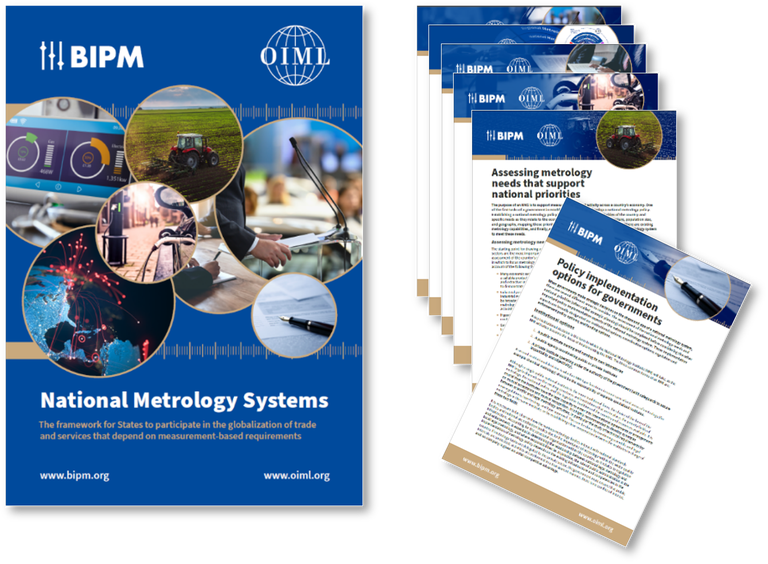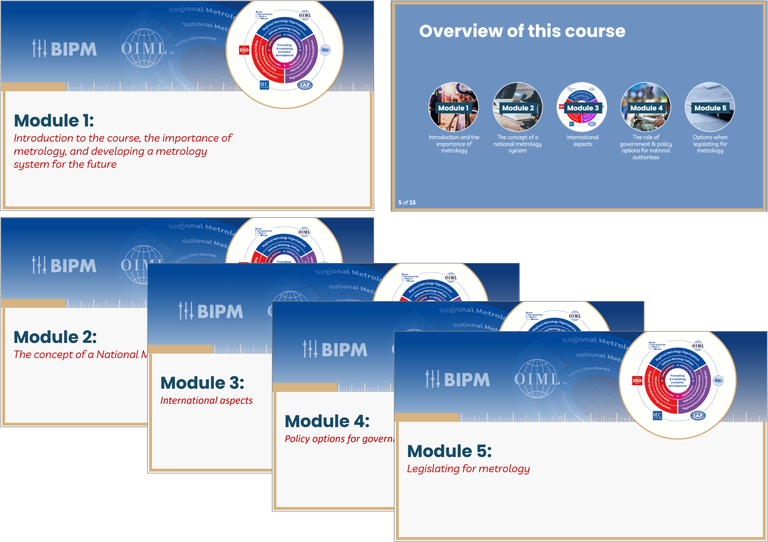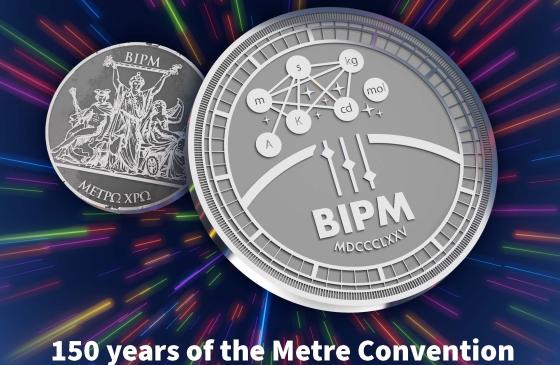OIML BULLETIN - VOLUME LXV - NUMBER 3 - JULY 2024
e v o l u t i o n s
BIPM-OIML Joint Knowledge Transfer initiative
Chingis Kuanbayev
BIPM
Ian Dunmill
BIML
1 Introduction
Seamless linking and delivering of scientific and legal metrology is important. This involves integrating the principles and practices of measurement science with legal metrology activities to ensure accuracy, reliability, and consistency in measurements worldwide. Therefore, the International Bureau of Weights and Measures (BIPM) and the International Organization of Legal Metrology (OIML) continue to collaborate as both organizations strive to present “one voice” for metrology to the outside world. One of the tangible outcomes of this collaboration is the BIPM and OIML joint publication: National Metrology Systems ‑ Developing the institutional and legislative framework (OIML D 1:2020) [1]. This joint publication gives advice to national authorities on the issues they should consider when producing policies aimed at developing their national metrology systems, setting up institutions dealing with metrology within their jurisdictions, and drawing up national laws related to metrology. All nations and economies with advanced metrology systems already participate in the activities of both organizations, as do an increasing number of economies with emerging metrology systems. However, there are a number of countries and economies with emerging metrology systems (CEEMS) that are still in the process of developing or reshaping their national metrology systems (NMS). Providing appropriate information tailored to assist CEEMS in designing their national metrology systems would facilitate their effective participation in the international measurement system.
2 The need for capacity building and knowledge transfer
Critical national and international goals addressing economic growth, innovation, energy and the environment, good health, food security and fairness of consumer transactions in the marketplace depend on accurate and trusted measurements of physical, chemical and biological quantities. It is important that a country has an efficient and appropriately funded metrological infrastructure because none of these quantities can be correctly and consistently measured without it. Indeed, States that successfully participate in the global marketplace and have a thriving, diverse national economy supporting their businesses and consumers typically have a formalized national metrology system linked to international scientific and legal metrology programs. Effective participation in metrology programmes, as part of the wider Quality Infrastructure has been identified by the United Nations Industrial Development Organization (UNIDO) as one of the elements necessary to achieve many of the United Nations (UN) Sustainable Development Goals (SDGs) which target 2030 [2]. UNIDO have further identified the need for such countries to have a Quality Policy related to the establishment of an effective quality infrastructure, and have developed guiding principles, technical guidance, and a practical tool to help them. These various guidance documents identify effective engagement with international organizations, including the BIPM and the OIML, as one of the steps on the road to development.
The 27th meeting of the General Conference on Weights and Measures (CGPM) in 2022 adopted a Resolution 6 “On universal adherence to the Metre Convention” [3] with the aim of opening new opportunities for states to participate in BIPM activities. The implementation of this resolution is likely to result in a new category of membership for those countries that are not yet engaged with the BIPM. Currently, 85 States (representing just 2 % of world GDP) of 193 UN Member States are not yet participating in BIPM activities as Member States or Associate States, although they may make use of the International System of Units (SI) and the Coordinated Universal Time (UTC). Appropriate actions will be proposed for consideration by the CGPM at its 28th meeting in 2026.
2.1 The BIPM Capacity Building and Knowledge Transfer (CBKT) Programme
This Programme, which was started following the 24th meeting of the CGPM in 2014, has been widely welcomed and has evolved rapidly to become a pillar supporting both national and regional metrology activities. The CBKT of the BIPM aims to increase the effectiveness with which Member States and Associates engage in the world-wide coordinated metrological system. Nowadays, the programme has a highly appreciated portfolio that continues to expand. The CBKT initiatives are delivered through various activities such as workshops, laboratory placements and remote-learning activities, including the BIPM e-learning platform, which also hosts knowledge transfer material from Regional Metrology Organizations (RMOs). Around 60 CBKT initiatives, designed to support national and regional metrology activities, were delivered with the involvement of 65 lectures and experts from the National Metrology Institutes, RMOs and International Organizations. There have been over 4 000 participations in-person and online from 126 countries, covering all six RMOs. The e-learning platform hosts more than 20 courses and has more than 1500 registered users.
2.2 OIML activities concerning Countries and Economies with Emerging Metrology Systems (CEEMS)
In 2013, the CIML established an Advisory Group on matters concerning Countries and Economies with Emerging Metrology Systems (CEEMS AG). The objectives of the CEEMS AG are to enable the CEEMS community to actively participate in OIML activities, to develop OIML support policies and plans for CEEMS, and to provide guidance for the OIML’s CEEMS activities.
Various CEEMS-oriented training courses, seminars, and online training activities have been organized to promote CEEMS capacity building. Significant achievements have been made, and the work of the CEEMS AG is now one of the pillars of the OIML’s strategy.
In 2023, the 58th meeting of the International Committee of Legal Metrology (CIML) approved a new initiative, put forward by Thailand. This “NEXT Legal Metrology Systems (LMS)” is intended to provide a methodology for the development of legal metrology at the national and regional levels, and methods for its implementation are currently being studied.
3 BIPM and OIML joint knowledge transfer initiative
Based on the above-mentioned motivations and demand from CEEMS countries, the BIPM and the OIML have agreed to organize a joint knowledge transfer initiative through their capacity building and knowledge programmes aimed at assisting their members in effective participation in the international measurement system. The first outcome of this knowledge transfer initiative is a Brochure with six accompanying inserts, the contents of which draw upon the BIPM and OIML joint publication “National metrology systems ‑ Developing the institutional and legislative framework” (OIML D 1:2020). The brochure and insert give information on the various aspects of national metrology systems:
- Umbrella brochure: National Metrology Systems
- Insert 1: The role of government in a National Metrology System
- Insert 2: International aspects of National Metrology Systems
- Insert 3: Assessing metrology needs that support national priorities
- Insert 4: Policy implementation options for Governments
- Insert 5: Legislating for metrology
- Insert 6: Developing a metrology system for the future

The brochure summarizes key elements that should be considered when producing policies aimed at developing national metrology systems, setting up institutions dealing with metrology, and drawing up national laws related to metrology. Written in an accessible way, the brochures are aimed at
- supporting countries and economies with emerging metrology systems in the implementation of International Document D 1,
- underpinning the 27th CGPM’s Resolution 6 “On universal adherence to the Metre Convention”, and
- underpinning Objective 5 of OIML B 15:2011 OIML Strategy on raising awareness of the contribution that a sound legal metrology infrastructure can make to a modern economy.
3.1 e-learning
The second outcome of the initiative is the e-learning course “National Metrology Systems” published on the remote resources of the BIPM and the OIML. It allows those interested in the material to access the course from anywhere and at any time. This flexibility accommodates diverse learning paces, making knowledge transfer more inclusive and accessible to a broader audience.
This self-study course contains five e-learning modules, which have the final goal of providing guidance to set up a national metrology system in a country or economy where it does not yet exist, or which has only partial elements of it. The course is intended to be taken in the order of the modules and
- lays out the importance of metrology (Module 1: Introduction and the importance of metrology),
- describes what is meant by a national metrology system and what its components are (Module 2: The concept of a national metrology system),
- places that system in the context of the wider international metrology system (Module 3: International aspects),
- describes what the role of the government should be and the policy options that may be available to national authorities (Module 4: The role of government & policy options for national authorities), and finally
- provides some options when developing legislation for metrology (Module 5: Options when legislating for metrology).

4 Conclusion
The need for a national metrology system is reinforced by the increasing participation of states and economies in trans-national, regional and international agreements following globalization of trade and services. A sound law provides the basis for establishing and maintaining the appropriate national measurement-based requirements. This latest BIPM and OIML knowledge transfer initiative provides a brochure and e-learning suite based on the joint publication “National metrology systems ‑ Developing the institutional and legislative framework” (OIML D 1:2020). This document provides the basis for developing such a law. The document, brochure, and course are available through the BIPM and OIML websites.
The BIPM and the OIML continue their close collaboration as both organizations strive to present ‘one voice’ for metrology to the outside world. The goal of this BIPM and OIML joint knowledge transfer initiative is to offer appropriate information and advice to national authorities on the issues they should consider when producing policies aimed at developing their national metrology systems, setting up their institutions dealing with metrology within their jurisdictions, and drawing up national laws related to metrology.
5 Acknowledgement
This knowledge transfer initiative has been prepared jointly by the BIPM and the OIML. We acknowledge the valuable contribution and support of Douglas A. Olson (NIST associate) and Andy Henson (formerly BIPM) in consultation with Peter Mason (former CIML President).
This BIPM and OIML joint initiative was funded by the Federal Institute of Metrology METAS, Switzerland.
A formalized national system for metrology benefits a country in many ways. It helps businesses compete globally, provides fairness and equity for consumers in the marketplace, and establishes a sound basis for scientific research and addressing the challenges of a society for the future. In my career I have participated in both its scientific and legal aspects, and have observed how it helps its citizens, industry and government. We hope this brochure describes a National Metrology System and its benefits in more detail, and provides guidance on the process for implementing it in your country.
Quote From Dr Douglas A. Olson (Formerly NIST)
6 References
[1] BIPM/OIML. BIPM-OIML publication: National Metrology Systems - Developing the institutional and legislative framework. BIPM. Published 2021. Accessed June 24, 2024. https://www.bipm.org/documents/20126/42177518/National-Metrology-Systems.pdf/3f13d88c-aef6-9c50-62dc-39fa6f48f6e9
[2] UNIDO-BIPM-OIML. UNIDO-BIPM-OIML joint brochure The role of metrology in the context of the 2030 Sustainable Development Goals. Published online 2020. https://www.unido.org/sites/default/files/2016-10/SDG_Standards___2__0.pdf
[3] BIPM. Resolution 6 (2022), On universal adherence to the Metre Convention. BIPM. Published 2022. Accessed June 24, 2024. https://www.bipm.org/en/cgpm-2022/resolution-6






